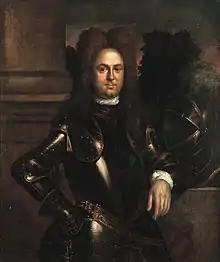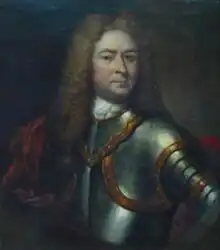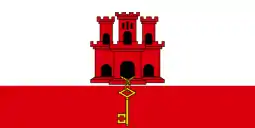Roger Elliott
Major General Roger Elliott (c. 1665 – 16 May 1714 [1]) was one of the earliest British Governors of Gibraltar. A member of the Eliot family, his son Granville Elliott became the first Count Elliott and his nephew George Augustus Eliott also became a noted Governor and defender of Gibraltar.
Roger Elliott | |
|---|---|
 | |
| Born | c. 1665 English Tangier, North Africa, or City of London, England |
| Died | 16 May 1714 (aged 49) Byfeld House, Barnes, Surrey, England |
| Buried | |
| Allegiance |
|
| Service/ | Army |
| Rank | Major-General |
| Battles/wars |
|
| Spouse(s) |
Charlotte Elliot
(m. 1712–1714) |

c. 1665-1714
with permission from
The Eliot Archives
Early life
Roger Elliott was born, possibly in London but more probably in the English Colony of Tangier in Morocco, to George Elliott (c. 1636 - 1668, the Chirurgeon to the Tangier Garrison) and his wife Catherine (née Maxwell, c. 1638 – 1709). George Elliott was the illegitimate son of Richard Eliot, the wayward second son of Sir John Eliot (1592–1632).
Roger Elliott's father, George Elliott, died at Tangier in 1668, and his widowed mother remarried there on 22 February 1670 to Robert Spotswood (17 September 1637 – 1680), the assistant and replacement Chirurgeon at the Garrison, and thirdly the Rev. Dr George Mercer, the Garrison schoolmaster. Roger Elliott was therefore an older half-brother of Alexander Spotswood (c. 1676 – 6 June 1740), who became a noted Lieutenant-Governor of Virginia.
Military career
By 1680, Roger was an Ensign in the Tangier Regiment of Foot, and was wounded on 27 October fighting the local Moors. In 1681, he was suspended by Colonel Percy Kirke[2] for duelling with Ensign Bartholomew Pitts, later being cashiered for this offence. He was sent back to England in 1682 with a letter begging for his readmission into His Majesty's Service, and he was reinstated as an Ensign in his old Company on 8 March 1683. In 1684 he returned to England. In 1685, the Tangier Regiment was renamed the Queen Dowager's Regiment of Foot, and he probably fought against the Monmouth Rebellion.
In 1687, he became a first lieutenant in the Earl of Bath's Regiment - created by Sir John Granville, 1st Earl of Bath (1628–1701). He was promoted to captain on 1 May 1690. He fought and was wounded at the Battle of Steenkerque on 3 August 1692. On 21 December of that year, he was promoted to major in the same Regiment, and, on 1 January 1696, promoted to lieutenant-colonel of Sir Bevil Granville's Regiment of Foot. In 1702, on campaign with the Duke of Marlborough, he was shot through the body at the defence of Tongeren in Belgium. He reputedly took on the entire French Army with only two regiments, before surrendering.
On 5 March 1704, he raised his own regiment – Colonel Elliott's Regiment of Foot. Officers were commissioned on 10 April that year at St James'. On 2 July 1704, again on campaign with the Duke of Marlborough, he fought and was wounded at the Battle of Schellenberg. It is possible that he fought at the Battle of Blenheim on 13 August 1704. However, he certainly did not lead the cavalry at this battle, as has been maintained by other biographies – this was led by General Sir John 'Salamander' Cutts.
Gibraltar
In March 1705, Colonel Elliott's Regiment of Foot embarked for Spain and served at Gibraltar, which was declared a free port in 1706. On 1 January 1707, he was promoted to Brigadier-General, and later that year to Lieutenant-Governor of Gibraltar.[3] On 24 December, he was appointed Governor of Gibraltar. His time in office is remembered in the Gibraltar records as one of mercenary opportunity; whereas, in the London records, it appears that he proceeded with expensive but vital defensive fortification with only minimal prior financial approval. The arguments over the accounts for these defences subsequently caused problems for the probate of his personal estate. On 1 January 1710, he was promoted to Major-General, and on 24 January 1711, he handed over the Governorship to Brigadier-General Thomas Stanwix. He finally departed Gibraltar on 18 June 1711.
Return to England
Elliott returned to England and leased Byfeld House in Church Road, Barnes, Surrey. He married, and had a small family. However, he never fully recovered from his wounds and died relatively early.
Family
On 4 March 1712 at St Peter upon Cornhill, London, Roger married Charlotte Elliot (c.1692 - c.1753), the daughter of William 'the Laceman' Elliot (c.1690 - 1728) of Brugh and Wells, a rich London merchant, and his wife Eleanor Tankard (1664–1745). They had two children:
- Granville Elliott (7 October 1713 – 10 October 1759), 1st Count Elliott, who married firstly Jeanne Thérèse du Han (1707–48) and secondly Elizabeth Duckett (1724–1804).
- Catherine (Kitty) Elliott (18 September 1714 – 15 January 1757), who married firstly c. 7 or 9 August 1736 Westminster to Charles Boyle (of Araglin Bridge, co Cork, related to the Earls of Cork and Orrery), and secondly, in 1742, to the Very Rev Robert Bligh (c. 1704 - 1778), the Dean of Elphin and a younger brother of John Bligh, 1st Earl of Darnley (1687 - 1728)
Mary Elliott, who married Garrett Fitzmaurice in Ireland, claimed to be a natural daughter of Roger Elliott.[4][5]
Roger Elliott never fully recovered from his various wounds and died at Byfeld House on 16 May 1714. He was buried 21 May in the cemetery of St Mary the Virgin, Barnes.
His will was probated on 16 November 1714[6] but his estate took longer to resolve because of the difficulties previously mentioned. The eventual resolution was mostly due to the involvement of his father-in-law, William 'the Laceman' Elliot, who sought to expedite his daughter's remarriage to Captain Thomas Burroughs.[7][8][9][10][11]
His widow remarried on 15 July 1715 at St James, Westminster to Captain Thomas Burroughs (died before 1728). She died before 1753.
References
- The Post Boy, 18–20 May 1714 "On Saturday night last dyed Major-General Elliott, late Governor to Gibraltar".
- Percy Kirke was Roger Elliott's first cousin once removed, with common ancestor Robert Killigrew (1580–1633)
- The National Archives | National Register of Archives | Admiralty Memorial | PRO PC 1/2/51 Admiralty memorial concerning the rival claims to a prize ship of the Lieutenant Governor of Gibraltar (memorial dated 5 February 1707: the captured prize ship, Nostra Seigniora del Rosario, master: Francis Pujal, was disputed by Roger Elliott and the Captain and crew of HMS Carcass. The decision was to split the prize, with 1/8 going to Roger Elliott and 7/8 going to the crew)
- Burke's Landed Gentry of Ireland, 1958 edition
- Burke's Irish Family Records, 1978 edition
- The National Archives | National Register of Archives | Roger Elliott | Prerogative Court of Canterbury - PROB 11/543/112, PROB 10/1515 CC 2646
- The National Archives | National Register of Archives | Elliott vs Burroughs | Chancery: Master Tinney's Exhibits (Bills paid by William Elliot on behalf of Charlotte Elliot) - C104/251, C11/1169/24
- The National Archives | National Register of Archives | Elliot vs Bucknell (1714) | Chancery: C11/848/117
- The National Archives | National Register of Archives | Elliott vs Lawrence (1714) | Chancery: C11/848/105, C11/1384/32
- The National Archives | National Register of Archives | Elliott vs Morris (1714) | Chancery: C11/1729/14, C11/2344/27
- The National Archives | National Register of Archives | Elliott vs Cleland (1714) | Chancery: C11/715/27, C11/715/33
- Jessica and Laura Eliot's Archive

